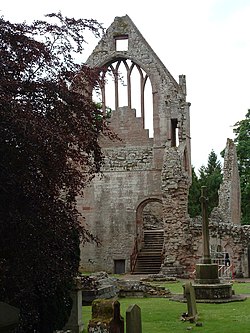Dryburgh Abbey
 |
|
| Monastery information | |
|---|---|
| Order | Premonstratensian |
| Established | 1150 |
| Disestablished | bet. 1581 and 1600 |
| Mother house | Alnwick Abbey |
| Diocese | Diocese of St. Andrews |
| People | |
| Founder(s) | Hugh de Morville |
| Important associated figures | Adam of Dryburgh, Andrew Forman |
Dryburgh Abbey, near Dryburgh on the banks of the River Tweed in the Scottish Borders, was nominally founded on 10 November (Martinmas) 1150 in an agreement between Hugh de Morville, Lord of Lauderdale and Constable of Scotland, and the Premonstratensian canons regular from Alnwick Abbey in Northumberland. The arrival of the canons along with their first abbot, Roger, took place on 13 December 1152.
It was burned by English troops in 1322, after which it was restored only to be again burned by Richard II in 1385, but it flourished in the fifteenth century. It was finally destroyed in 1544, briefly to survive until the Scottish Reformation, when it was given to the 2nd Earl of Mar by James VI of Scotland.
The 12th Earl of Buchan bought the land in 1786. Sir Walter Scott and Douglas Haig are buried in its grounds.
The Premonstratensian order was founded by St Norbert of Xanten who was firstly a canon at Xanten Cathedral. Unhappy with the way of life of his fellow canons, he left the Rhine lands for the diocese of Laon, in the north of France where the reforming Bishop Bartholomew was transforming his see into one that was more apostolic. Bartholomew persuaded Norbert to form a canonical order at Prémontré, in Aisne in 1120 and while the order was Augustinian in form, the canons wore the white habit and not the black. They followed an austere monastic life, but had a duty to preach and teach to those on the outside of the monastery walls. The order spread rapidly across Europe with the Abbot of Prémontré becoming Abbot-General for all the daughter-houses. Even before the first Abbot-General Hugh of Fosse died, one hundred and twenty abbots attended the annual general chapter. The Premonstratensians took on many of the methods of the Cistercians including land management and the use of lay-brothers to undertake the labour-intensive work of the communes.
...
Wikipedia
